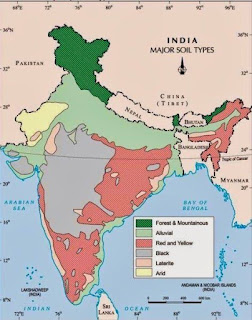Types of soils in India

TYPE'S OF SOILS IN INDIA Definition of Soil : Soil can be simply defined as a mixture of small rock particles/debris and organic materials/ humus which develop on the earth surface and support growth of plants. Soil Classification – Urvara vs Usara : In India, soil had been classified from the ancient period itself even though it was not as detail as the modern classifications. In the ancient period, the classification was based on only two things; whether the soil is fertile or sterile. Thus the classification were: Urvara [fertile] Usara [sterile] Soil Classification – Agencies involved : In the modern period, when men started to know about the various characteristics of soil they began to classify soil on the basis of texture, colour, moisture etc. When the Soil survey of India was established in 1956, they studied soils of India and their characteristics. The National Bureau of Soil Survey and the Land Use...
